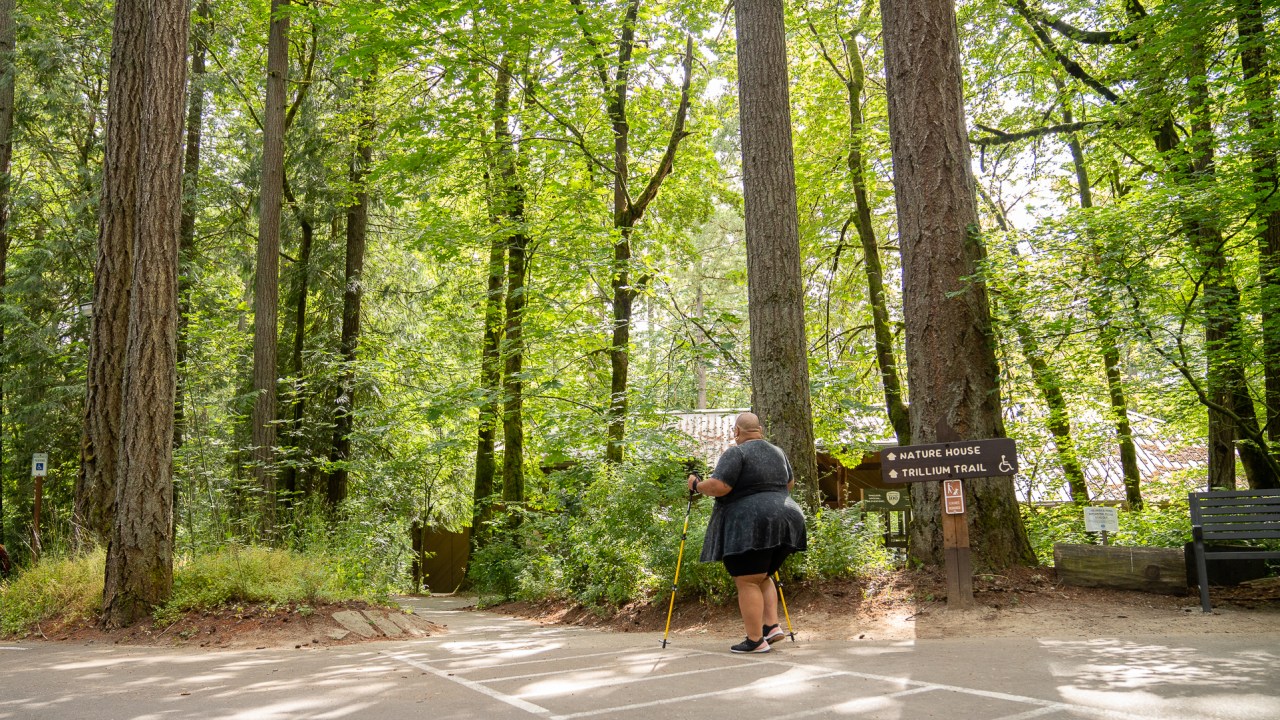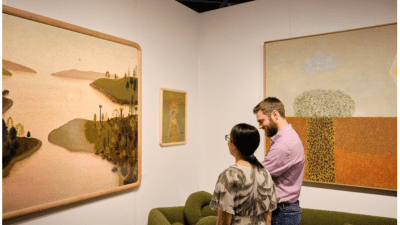
The American Alliance of Museums offers the following information from Violet Rose Arma, Curatorial Assistant & Administrative Support, University of Arizona Museum of Art. The information shared here is based on the best available information as of publication.
Traditional museum experiences sometimes lack regard for differing ability levels and perspectives, causing certain groups to feel excluded—including disabled communities. It is essential to create environments that are both physically and culturally accessible—meaning all audiences have access to the information and objects being presented and can learn from them. The implementation of universal design (UD) and universal design for learning (UDL) allows museums to acknowledge and embrace diverse audiences with a variety of ability levels.
Universal Design
Universal design (UD) is defined by Dr. Sheryl Burgstahler as “the design of products and environments to be usable by all people, to the greatest extent possible, without the need for adaptation or specialized design.” There are seven basic principles of UD:
- equitable use
- flexibility in use
- simple and intuitive use
- perceptible information
- tolerance for error
- low physical effort
- effective size and space for approach and use
Below you will find key tips and questions to ask when integrating these concepts into your museum space alongside helpful examples from a variety of settings:
Is the design useful for people with different ability levels? Put yourself in the shoes of others and invite your audience to critique the accessibility of your museum.
A prime example of equitable use is the curb cut. Curb cuts were originally introduced along with the Americans with Disabilities Act in 1990. Now they are useful to all people, creating access points for a variety of groups to successfully navigate sidewalks in urban areas. Further reading on the “curb cut effect” can be found in this article from the UX Collective by Emma Sheridan.
Have you accounted for a wide range of preferences and abilities? Think about the diverse audience of visitors and learners you serve or plan to serve. How can your institution bend and morph to fit their needs rather than it being the other way around?
Flexible use can be upheld by providing both a physical label for viewers to read as well as an audio description for those who cannot or prefer not to read labels. The Museum of Modern Art (MoMA) in New York City provides verbal descriptions of several artworks on view through their website and the Bloomberg Connects app.
Is the design easy to understand and use, regardless of prior knowledge? Your audience brings a wide range of experiences, languages, and concentration levels to the museum space. It is our job as museum professionals to create content that is simple and intuitive, breaking down barriers for visitors.
A place where simple and intuitive use can be exemplified is within signage. Universal symbols can be used instead of text to encourage more streamlined interactions. When the use of text is necessitated, multiple languages including Braille and ASL can improve access.
Does the design communicate the information effectively regardless of ability level? Though it might seem impossible, it should be a goal for museum content to communicate necessary information to everyone regardless of their sensory abilities. Giving a variety of ways to perceive information benefits all visitors.
A traditional museum label can be accompanied by an audio guide or a tactile model of the work. An example is the Isabella Stewart Gardner Museum’s audio guide that is used in conjunction with a physical or PDF map of the space.
Do you account for and minimize accidental and unintended consequences? Let’s face it: we all make mistakes. It is crucial to acknowledge this fact by anticipating common errors, therefore lessening negative consequences or hazards during the experience. Make a point of sharing information about potential roadblocks with visitors when they enter the space.
While it is ideal to design our museums to be as navigable as possible, errors are inevitable when visitors are unfamiliar with the space and its surroundings. The University of Arizona Museum of Art (UAMA) in Tucson, Arizona helps to negate this by providing ample wayfinding signage and regularly updating maps for ease of access.
Can the design be used with little effort, efficiently and comfortably, and with minimal fatigue? If you find that ease of access can be improved, take note, and act. This might be as simple as ensuring there are stools or benches located within the galleries for visitors to stop and rest.
This article titled “Take a Seat” by Steve Tokar details the benefits of offering seating options within museums.
Is the design a size and shape that allows users of every size, posture, or mobility level to utilize it? It is important to think about whether components of a design can be adapted or adjusted for the user.
Labels for museum objects should be placed in the line of sight for any seated or standing user. Similarly, visitors should not have to stoop or reach to gain access to tactile content. Access Smithsonian provides a multitude of resources pertaining to this topic, including the Smithsonian Guidelines for Accessible Exhibitions.
Universal Design for Learning (UDL)
Universal design for learning (UDL) allows UD to reach beyond physical accessibility into the realms of learning and engagement, creating an environment that is for learning rather than just access. CAST, an education research and development nonprofit, has created a UDL framework that can be utilized as a set of best practices with a primary focus on three principles: multiple means of engagement, representation, and action and expression concerning accessibility and learning within interpretive spaces.
Here are some more key tips and questions to ask when integrating these concepts into your museum space:
Are there multiple means of engagement that can stimulate the visitors’ interest and contribute to learning? A design should cater to various levels of perception, languages, symbols, expressions, and comprehension, encouraging purposeful and meaningful interaction.
The High Museum of Art in Atlanta has showcased this principle through its Outside the Lines exhibition. This immersive maze experience was designed in coordination with the Center for the Visually Impaired in Atlanta, incorporating a variety of textures, textiles, and means of interaction. The format encouraged all visitors to touch, experience, and play within the space.
Is the content presented in different ways? By presenting content in more than one way, various groups can be represented. There is no one-size-fits all approach to museum exhibition spaces. A design should provide options for physical action and demonstration of expressive skills and fluency, so no one is left out.
The Georgia O’Keeffe Museum in Santa Fe, New Mexico, provides visual, tactile, and auditory exhibition design elements that can be used in combination or isolation depending on ability level. Visitors can view O’Keeffe’s paintings and sculptures while feeling 3D models of their subjects and listening to an audio guide.
Are there several ways for users to express what they do or do not know? Asking for feedback is crucial. A design should encourage participation through multiple avenues and invite feedback so we know what we can do better next time.
Many museums encourage visitors to share about their experience through surveys. The Harvard Art Museums in Cambridge, Massachusetts, provides an iPad on a stanchion so visitors can easily fill out a simple yet effective satisfaction survey.
Implementing UD and UDL in Your Museum
Cultivating Empathy: Fostering a culture of empathy at both a personal and organizational level is crucial to the integration of UD and UDL concepts. Empathy is defined as the ability to understand and share in the feelings of another. In the museum context, this means imagining ourselves in the place of our visitors.
- For more reading on empathy in the museum, please consult Elif M Gokcigdem’s Fostering Empathy through Museums.
Arranging Professional Development and Education: The integration of universal design within our museum spaces starts with the education of the professionals who practice there. Professional development centered around these topics is crucial to the implementation of each principle. Some helpful resources:
- CAST UDL Guidelines
- Sheryl Burgstahler’s “Universal Design: Process, Principles, and Applications”
- Valerie Fletcher’s “Going Beyond: What Does Universal Design Look Like?”
Working with Accessibility Consultants: Consulting with experts in the field of accessibility may provide a helpful perspective for museums who are unsure where to start on their journey with UD and UDL concepts. This might be in a more formal or informal capacity depending on the resources available to your particular institution.
- The Art of Access: A Practical Guide for Museum Accessibility by Heather Pressman and Danielle Schulz acts as a helpful starting point for museums to integrate accessibility initiatives.
Prioritizing Equitable Access: Championing for equitable access beyond the surface level of compliance is essential to the success of universal design and universal design for learning initiatives. Take the time to listen to people’s stories and lived experiences.
- Museums as Agents of Change by Mike Murawski includes important conversations about diversity, equity, and inclusion.
- Year of the Tiger: An Activist’s Life by Alice Wong is a powerful memoir that calls attention to the continued fight for disability justice in our society.
Starting Small, Aiming Big: While fulfilling each principal of UD and UDL may seem daunting, taking an incremental approach may make your institution’s goals more attainable. Perhaps the first goal is ordering stools to be placed in the galleries and the second is providing audio description for the works in your newest exhibition. Piece by piece, we can build institutions that serve wider and more diverse audiences.
- Gabrielle Rappolt-Schlichtmann and Samantha G. Daley’s “Providing Access to Engagement in Learning: The Potential of Universal Design for Learning in Museum Design” discusses promising projects in the field of UDL that other institutions can draw upon for inspiration.
End Note
Accessibility starts with you. It is my hope that this list of tips, questions, resources, and examples may reach beyond your screens and inspire you to create museums that are truly for all to enjoy.









Comments